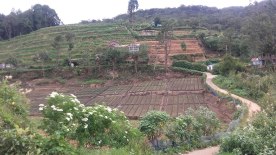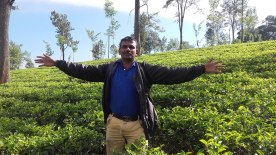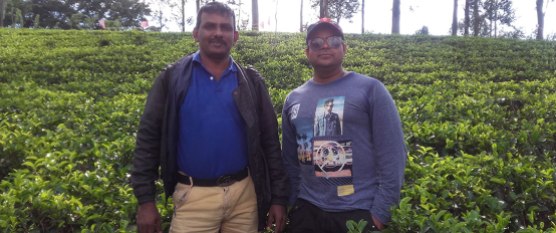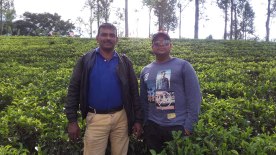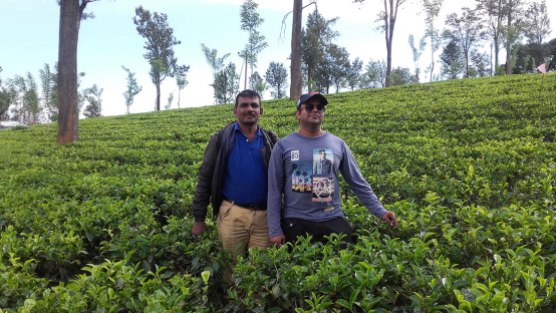
On the third day of our motorcycle journey, August 10, 2016, Meer Ali and I left the guest house in Nuwara Eliya around 9.00 am. The Lake Gregory nestled among the misty hills was beckoning and we rode towards the Lake Gregory, enjoyed the beautiful scenery and the cool breeze for a while, before getting back on the road once again towards the Nuwara Eliya City. Lake Gregory, which is situated at an elevation of 1,874 meters created by the British who ruled the island for some 150 years from 1815 till 1948 and named it after one of the British Governors in Colombo. The English liked Nuwara Eliya because of its temperate climate. In fact, Nuwara Eliya is also known as “Little England” to date due to its colder climate, British style architecture and a host of other similarities. For some time, we did not feel like leaving such a beautiful garden city like Nuwara Eliya, probably the most beautiful in the whole country. But we had a mission to complete and continued with our motorcycle journey once again.
If you want to read more on Nuwara Eliya, please read the passages below courtesy of some other sources.
“The city of Nuwara Eliya ( City of Light) was founded by the Englishman Samuel Baker, the discoverer of Lake Albert and the explorer of the Nile in 1846. Nuwara Eliya’s climate lent itself to becoming the prime sanctuary of the British civil servants and coffee, tea & rubber planters in Ceylon (or present-day Sri Lanka.) Nuwara Eliya, is also known as Little England, was a hill country retreat where the British colonialists could immerse in their pastimes such as fox hunting, deer hunting, elephant hunting, polo, golf and cricket.
Although the town was founded in the 19th century by the British, the district is today visited by native travelers, especially during April, the season of flowers, pony races, go cart races and auto rally.
Many of the buildings retain features from the colonial period such as the Queen’s Cottage, General’s House, Grand Hotel, Hill Club, St Andrew’s Hotel and Town Post Office. New hotels are often built and furnished in the colonial style. Visitors the city can wallow in its nostalgia of bygone days by visiting the landmark buildings. Many private homes maintain their old English-style lawns and gardens.
Due to its highland location, Nuwara Eliya has a subtropical highland climate having no pronounced dry season, a monsoon-like cloudy season and with a mean annual temperature of 16 °C (61 °F).
In the winter months, there can be frost at night, but it warms up rapidly during the day because of the high sun angle.
The town’s attractions include a golf course, trout streams, Victoria Park, and boating or fishing on Lake Gregory. Victoria Park is an attractive and well-used oasis. It is popular with birdwatchers at quieter times because of the good opportunities for seeing species, particularly the Indian blue robin, pied thrush or scaly thrush lurking in the denser undergrowth. The Kashmir flycatcher is another attractive bird species in the park.
Galway’s Land Bird Sanctuary, close to Lake Gregory, is an area of montane forest a few kilometers east of the town. Covering an area of 0.6 km, it is home to many bird and mammal species endemic to Sri Lanka, including wild boar and barking deer.”

Nuwara Eliya City, Sri Lanka
Our next stop was at the spectacular Post Office building in the city which is located in the center of Nuwara Eliya town and is one of the oldest post offices in Sri Lanka. The Tudor-style two-storey red-brick building with a clock spire, was constructed in 1894 by the British. We took pictures of this Post Office. I am certain this may be a strong contender to be one of the world’s ten most beautiful post office buildings. There were some rumors a few months back, that this 124-year-old post office was to be sold to an Indian businessman who intended to convert it into an Indian restaurant. The proposal was met with angry protests by the city folks and the workers of the postal department in Nuwara Eliya. Hence, the plan was temporarily withheld. Read more here: https://www.pressreader.com/sri-lanka/sunday-times-sri-lanka/20170604/281668254940656.

Post Office, Nuwara Eliya

Farms close to Nuwara Eliya town.
Our next stop was at the famous Seetha Amman Temple in Sita Eliya (Sita is written as Seetha by being more faithful to the way it is pronounced by Sri Lankans.) Legend says that this is the area where the Indian princess Sita was said to have been held in captivity by the all-powerful Sri Lankan king Ravana, to hurt the pride of the Indian prince Rama who was the husband of Sita.
(I will publish a separate post on the Ramayana epic once I finish writing about our own epic 5-day motorcycle journey.)
History and legends apart, the temple (also called kovil by Hindus) is a beautiful structure and both Meer and I took a lot of pictures of it from various angles. It is well-maintained and clean.

Seetha Amman Temple, Seetha Eliya, Nuwara Eliya
We stopped by famous Hakgala Botanical Gardens one of the oldest botanical gardens in this part of the world around 1.00 pm. (The garden was established in 1861, under George Henry Kendrick Thwaites as an experimental cultivation of Cinchona, a commercial crop thriving at the time. Once the Tea replaced the Cinchona, it was turned into an experimental Tea cultivation. In 1884 it transformed to a garden. Since then many sub-tropical and some temperate plants planted in the gardens. – Wikipedia)
It was a mesmerizing place full of various flowers and huge fern trees (which might have left unharmed since the Jurassic Age I guess.) When you see these treasures of nature, it is apparent that you feel antagonized about the British colonialists, the only Western power who were able to capture the whole of Sri Lanka (then Ceylon) as to what damage they have inflicted to this otherwise evergreen rain-forest in the Central Hills of Sri Lanka by introducing coffee, cinchona, then tea and various non-endemic flora for mere industrial and commercial purposes by uprooting and decimating (in my words, by raping, savaging and ravaging) the island’s virgin rain forest canopy, especially right throughout these hilly terrains, eventually causing in the process long periods of droughts in other parts of the country, as can be seen today. Since I am not an ecologist or an environmentalist but a naturalist, I had do better wind up the commentary on how the English planters completely bared vast swaths of island’s pristine primordial forestation.)

Huge fern trees at Hakgala botanical Garden, Nuwara Eliya, Sri Lanka

A rose bush in Hakgala Botanical Garden

Meer Ali in a place between Nuwara Eliya and Bandarawela.

Meer Ali enjoying “Ceylon Tea) in a place between Nuwara Eliya and Bandarawela.

Nanda Wanninayaka in a tea garden.

Nanda Wanninayaka and Meer Ali
Next, we proceeded to Bandarawela, one of the best honeymoon locations (which I too had the pleasure of enjoying in 2006) in the world. As we crossed the Nuwara Eliya district boundary, the landscape began to change. The closer the Badulla district, the more you get to see vegetable farms than tea estates. Still, it is a beautiful sight to behold and I wonder if anyone would complain about the change.

Rawana Falls, Sri Lanka
We reached Ravana Falls passing beautiful mountain ranges via Bandarawela and Ella, one of the most visited places by the foreign tourists in the Hill Country of Sri Lanka. Once you pass Ella and reach Ravana Falls, you begin to feel that the climate has had a drastic change. Till Ella, misty mountains with with intermittent showers, drizzles, rainbows, endless tea gardens, beautiful waterfalls, and so forth kept soothing our souls and bodies, but the moment you go down to Ravana Falls, you are in the Dry Zone. The precipice is so steep and one cannot understand how a whole climate system changes within such a small distance. I doubt whether similar places are elsewhere in Sri Lanka to see such a sudden and vast climatic difference within such a short time and distance.
Meer and I spent quite a time at Ravana Falls and here a crafty vender of corn cobs locked horns with me as I bought corn cobs for Meer also for the Sri Lankan rates. He immediately recognized Meer was not Sri Lankan and has to pay more for corn cobs. The funny part of this is that not a single traffic policeman could recognize Meer was not a Sri Lankan during almost 1000 km motorcycle journey to issue him a ticket for not having an international driving license authenticated or attested by the Department of Motor Traffic in Sri Lanka😊. Meer and I took turns in riding the bike.
We reached Tissamaharama by late night on the bike by passing Wellawaya and Thanamalvila. Our plan for the next day was to ride to Yala National Park.
*Thanks Mr. Lionel Balasuriya (USA) and Mr. Sunil Rutnayake (Sri Lanka) for giving me a hand with providing more facts and editing the post.
























